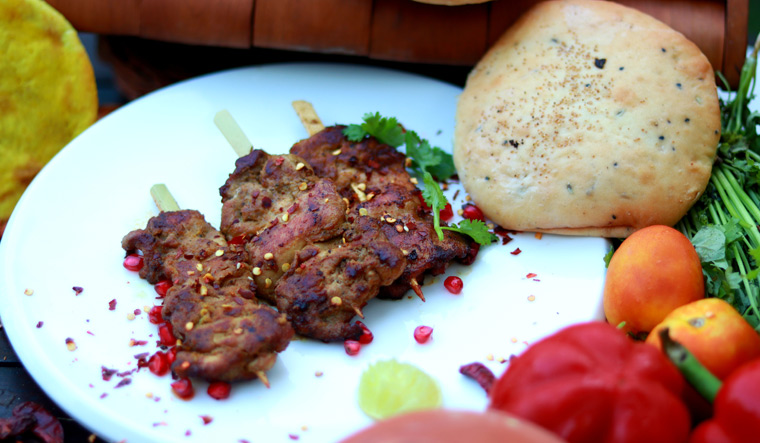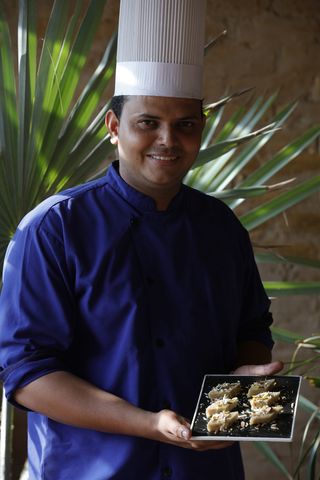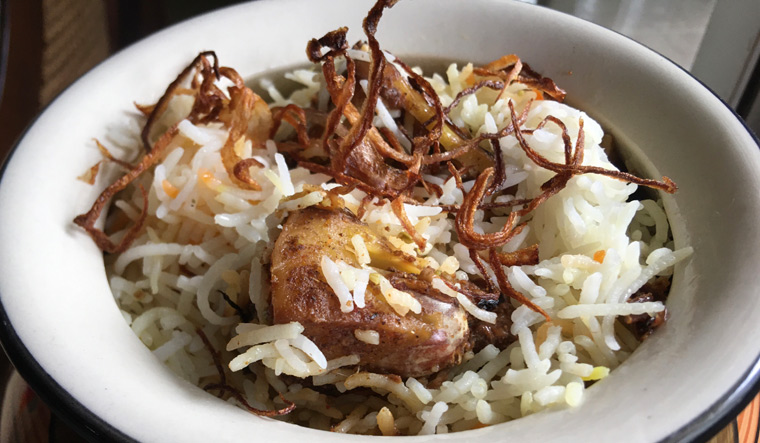To eat or not to eat is not a Shakespearean dilemma with a biological twist. It is a question of anthropology- of what cultures deem fit, of geography- of what is available and of culture- of what can nurture creativity. And under the rulers of Avadh, it was the question and the answer to what it meant to live amidst a constantly evolving refinement.
In the court of Avadh- fashion, poetry, calligraphy, architecture, music and dance scaled never experienced heights. And in its cuisine, there was a coming together of all that it meant to experience the most delicate and the most heightened visual, artistic, spiritual, and gastronomical delights.
There is nary a city in today’s India which does not have at least one restaurant offering Avadhi delicacies. But most of these are derelicts with just a label that is expected to miraculously conjure the tastes that were so relished in what was once India’s most glittering court.
The most obvious but overlooked of these representations comes in form of the biriyani. It is a dish ubiquitously attributed to Avadh with many heated arguments over which city between Hyderabad and Lucknow produces the better variety. Yet it is a delicacy that was never cooked in the province to start with!
Biriyani came to Avadh from Delhi and Hyderabad with the royal brides who brought their retinue of cooks with them. But the parboiled rice with meat pieces was at once declared by the nawabs to be too coarse for their delicate palettes. Thus, efforts were made to improve it. This resulted in the yakhni pulao in which the rice was cooked in rich meat stock and no bone pieces or whole spices obstructed its eating.
‘Dastarkhwan-e-Avadh- The cuisine of Avadh’, written by Sangeeta Bhatnagar and Raj Kumar Saxena, is a book that contains many recipes from the kitchens of the erstwhile royalty and elite. These recipes that were tried, re-tried and perfected by the authors come together in what remains a definitive book on the region’s cuisine. Its popularity is evident from the fact that since its first edition in 1997, the book has been often quoted and more often plagiarized.
Bhatnagar says that while there is a revival of interest in Avadh’s cuisine, big misconceptions about it remain. One of the most glaring of these is that the cuisine is synonymous with Mughlai food, despite the historical and political fact that Avadh was a different kingdom.
She offers an easy primer on the standout difference- Mughlai food has overpowering spices (and often excessive use of kasoori methi or fenugreek) and the finished product will have whole spices and often swim in oil. In Avadhi food, everything is ground to a fine paste. Even curries are sieved through a muslin cloth. “It is a smooth symphony of flavours”, she says. So smooth is this blending that the true flavours of Avadhi kitchen will not even smell of ghee (clarified butter)- the cooking medium used. This is achieved by what is known as ‘ghee durust karna’. That is a tempering of the cooking medium with the addition of kewra water (distilled extract of screwpine flower) and cardamoms so that the smell of its rawness is eliminated.
So why was the variety of such a refined cuisine lost over the years? And why did it come to be identified almost solely with kebabs and (the misleading) biriyani? And why was it so wrongly limited to only non-vegetarian food?
Saxena, who was serving as the director of the Institute of Hotel Management, Lucknow when he was asked to write the aforementioned book, says that the food still exists but in a ‘modified, corrupted form’.
“Unlike, say French cuisine, the history, documentation and classification of which is well preserved, there is little written material available on local cuisines. This is true of other cuisines as well such as Punjabi food. Much of the experimentation and art was born in the kitchen of the elites and was not in the public domain”, says Saxena.
There is also the challenge of how food was cooked. The maxim- that which is cooked slow tastes best, is almost impossible to follow in this day of fast, processed and convenient food.
‘Dadi/Nani se suna tha’ (heard it from my grandmother) often remains the most quoted source for where and how some of the lost recipes are sought to be recreated.
It was these memories that Mohsin Qureshi, the chef of Azrak restaurant at Lucknow’s Lebua Hotel dug into to capture the essence of the flavours of yore. Qureshi comes from a family of chefs or khansamas as they were then known. An ancestor also had a certificate of appreciation from Queen Elizabeth. “The journey from khansamas to chefs gave us hope that our calling would not die out”, says Qureshi.
At Azrak, Qureshi curates food experiences attempting to never repeat the dishes. His patrons include film stars, and on the day he meets us, one is around at the restaurant. “The spices are the key to Avadhi food”, he says listing jarakus (lemon grass), pathar ke phool (black stone flower) and the stem of betel leaves as some long-forgotten condiments. “The leaves of cauliflowers and taro made for some of the most sumptuous dishes' ', he says dismissing the myth that Avadhi cuisine has no place for vegetarian dishes. He serves up anjeer (fig) and cream kebabs to prove this point. Both the flavours come through delicately.
However, a reliance on memory can also lead to some level of subterfuge. One example of this is a dish called ‘Wajid Ali Shah ke baghare baingan’ (fried aubergine of Wajid Ali Shah- Avadh’s last nawab). In the few texts which document the foods of the time, there is no mention of this dish. And thus, there is no story attached to it. But food and stories must go together. For instance, as in the Pavlova meringue- a dessert named after a Russian ballerina and created when she toured New Zealand and Australia.
Subterfuge was elevated to an art form in Avadh’s erstwhile kitchens. In the book ‘Lucknow- The Last Phase of an Oriental Culture’, Abdul Halim Sharar, who served in the court of Wajid Ali Shah, recounts some such examples. In one, a ‘light tasty and delicious’ murabba (a conserve) was placed before a prince invited to dine with Shah. But though it looked like a conserve, it was a meat curry and left the connoisseur guest highly embarrassed at his inability to recognize it.
Shahnawaz Qureshi, the chef at a Lucknow restaurant called Tanatan (a slang for spiffy) has put this deception to use in the chicken barfi (a sweetmeat that looks like snow) he creates in his kitchen. He picked on the idea from a dish called ‘mirchi ka halwa’- an antithetical sounding dish for how can chilli be a dessert? For the sweetmeat, which Qureshi produces only on request, minced chicken leg and breast are boiled in a paste of ginger and garlic paste, repeatedly strained, and added to ground split Bengal gram. “Those who have not eaten it do not ask for it. But once you eat it, you will ask for it repeatedly”, says Qureshi.
The delights of Avadh’s kitchens were not limited to the elite. Commoners too would revel in the cooking and laying out of food. (The latter is captured in the evocative word dastarkhwan which means the spread of a meal.)
Noor Khan, an educationist and a food enthusiast who participates in a yearly festival of crafts, food and culture in Lucknow, cooking her kheema lal mirch (mince meat in red chilies) for the Sunday lunch in the gathering says that in her family of government officers eating in tune with the season was as much in vogue as was in the homes of the elite. “If it is the season of mangos, they will be used to add a tanginess to lentils, and for conserves and pickles. If papayas are in season, they will be used to tenderise meats”. Thus, eating what was fresh and seasonal was the norm in Avadh long before modern-day food scientists espoused it.
Sweets and desserts, much-maligned in today’s health lexicon also enjoyed an exalted position. To partake of these was spoken of in the words ‘muh meetha karna’- or to sweeten the mouth. The Muslims who made these were called rakabdars, the Hindus, halwai
Ravindra Gupta, the chief executive officer of Chappan Bhog, one of Lucknow’s most popular sweet shops says that halwais are traditionally a community ordained in the oldest religious texts to cook the foods that are to be offered to the Gods. In a larger reference to this, food is referred to as a naimat or blessing.
“Our ancestors never practiced any trade other than the making of sweets. We have modified traditional sweets such as the balushahi (doughnut) and malpua (pancake) to convenient, bite-sized pieces. The simple amalgamation of ghee, wheat and sugar produces the most naturally delicious food that one cannot resist”, he says.
For true food lovers, no lane is too narrow and no distance too large to partake in Avadh’s delicacies. A little over 20 kilometres from Lucknow is a small town called Kakori- which lends its name to one of the best-known kebabs.
Here, on a pushcart, Faheem Ahmad skewers seekh kebabs which draw film stars and politicians. Ahmad is a fourth-generation expert of these kebabs which melt in the mouth. He lists ingredients that go into these- cloves, papaya, black pepper, cream, poppy seeds, almonds etc. “Then there are the secret ingredients. The taste comes from the hand grinding of these on a mortar”, he says. It is a task to which the whole family contributes.
Sheeba Iqbal has been curating Avadhi dining experiences at her lavish home in old Lucknow since 2018. She says that over time there has been a steady rise in the number of tourists who reach out to her to experience the Avadh of yesteryears. “It is the true travellers who scour lanes and bylanes who come to me. It makes me happy that more and more young people are attracted to it", she says.
It is in these experiences that the dilemmas of food dissolve in a gush of deliciousness. And the glories of Avadh are re-born and re-lived.
Recipes:
Murg Ke Parche
Ingredients
500 gm Chicken breast
Salt to taste
25 gm Ginger garlic paste
2 tsp Lemon juice
100 gm Fried onion paste
1 tsp Yellow chilli powder
½ tsp Black pepper powder
¼ tsp Green cardamom mace powder
¼ tsp Black cardamom powder
2 tbsp Ghee
1 drop Sweet ittr
2 tsp Kewra water
½ tsp Chat masala
20 gm Green coriander
1 tbsp Pomegranate seeds
Servings – 3-4
Prep time - 20 minute
Cooking time - 15 minute
Directions
1 Wash chicken breast, remove excess fat and cut into thin slices.
2 Marinate chicken slices with ginger garlic paste, lemon juice, salt and keep aside for two hours.
3 Make smooth paste of fried onion and remaining ingredients. Then add the marinated chicken slices and mix well, keep aside for three to four hours.
Put chicken slices in a wooden skewer.
4 Grill the marinated chicken skewers on moderate temperature till done.
5 Serve along with ring onion, lemon wedges and mint chutney. Sprinkle chat masala and pomegranate on top.
Courtesy: Chef Mohsin Qureshi
Avadhi Kathal Pulao
Ingredients:
1/2kg Jackfruit (peeled, washed and cut into 1 1/2’’pieces)
2 1/2 cups, long grain Basmati Rice
3 medium sized onions
1 tsp ginger-garlic paste
6 green chillies (washed and slit)
2 tbsp yoghurt (whisked)
1/4 cup milk
1/2 tsp saffron
1 bayleaf
1 brown cardamom
4 green cardamoms
6 cloves
1’’piece cinnamon stick
1 tsp mace
I/2 tsp coriander powder
1/2 tsp cumin powder
1/2 tsp red chilli powder
1tbsp cumin seeds
1 tbsp coriander seeds
1 tbsp fennel seeds
1 tsp whole black peppercorns
Salt to taste
200 g ghee
Dough for sealing
2-3 pieces of coal (optional)
Method:
1 Wash and soak the rice for at least 15 minutes.
2 In a large sauce pan, boil water (approx. 3l), with 2tsp salt, bay leaf, brown cardamom,4 cloves, 2 green cardamoms, mace, whole coriander seeds, cumin seeds, fennel seeds, peppercorns and green chillies, for 15 mins. Then strain the water and keep aside. Discard the whole spices.
3 Dissolve the saffron strands in lukewarm milk.
4 Peel the onions. Finely slice 2 onions, and grind to a paste 1 onion.
5 Heat the ghee in a kadhai, reserving 2 tbsp for later use.
6 Fry the sliced onions to a light golden colour, remove and place on absorbent paper.
7 Pat dry the, the jackfruit pieces, with a kitchen towel, and fry in the ghee till golden brown, remove and keep.
8 In the same ghee, add 2 cloves, 2 cardamoms and stick of cinnamon, then add the onion paste, stir for 2 mins., then add the ginger-garlic paste and the powdered coriander, cumin and red chillies. Reduce the heat to minimum, then add the yoghurt and salt to taste, stir gently. Cover and cook on low for 5 mins. Then remove from the stove.
9 Now put the saucepan of the spice-flavoured water on the stove and bring to a boil. Add the soaked rice, gently, and cook on medium heat till almost done. Remove from the heat and drain out the water, and quickly spread on a greased tray. Check for salt, if needed, season with salt, and drizzle the reserved ghee. Gently toss the rice so that the salt and ghee mix evenly.
10 Now, in a heavy bottomed vessel, deg or kadhai, layer half the rice, place the cooked jackfruit pieces on top, discard the whole spices, then cover with the remaining rice. Drizzle the saffron milk, put the lid on, and seal with dough. If you have hot coal, place 2-3 pieces on the lid, if not, cover with a thick cloth and cook on low heat for 10 mins. When done, give the vessel a gentle shake, then remove the lid and serve on a platter, garnished with the fried onions.
Serve with a raita.
Courtesy: Sangeeta Bhatnagar





